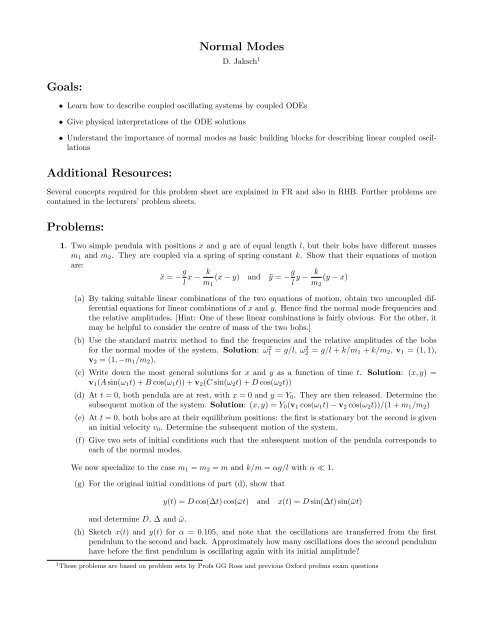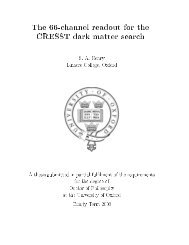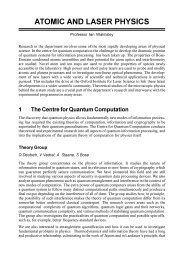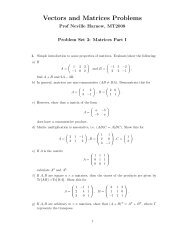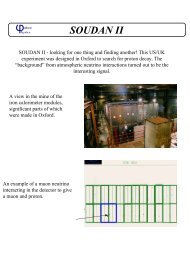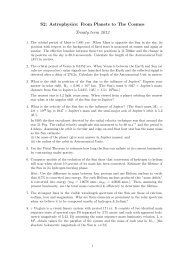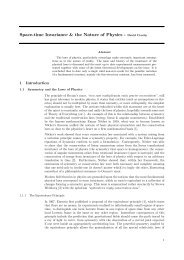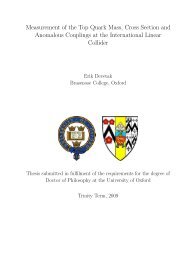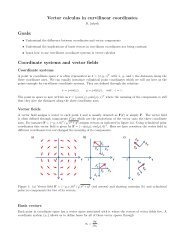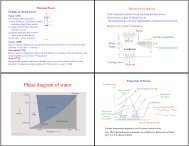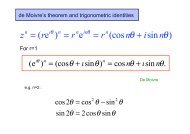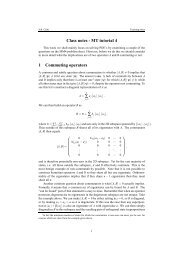Normal Modes Goals: Additional Resources: Problems:
Normal Modes Goals: Additional Resources: Problems:
Normal Modes Goals: Additional Resources: Problems:
You also want an ePaper? Increase the reach of your titles
YUMPU automatically turns print PDFs into web optimized ePapers that Google loves.
<strong>Normal</strong> <strong>Modes</strong><br />
D. Jaksch 1<br />
<strong>Goals</strong>:<br />
• Learn how to describe coupled oscillating systems by coupled ODEs<br />
• Give physical interpretations of the ODE solutions<br />
• Understand the importance of normal modes as basic building blocks for describing linear coupled oscillations<br />
<strong>Additional</strong> <strong>Resources</strong>:<br />
Several concepts required for this problem sheet are explained in FR and also in RHB. Further problems are<br />
contained in the lecturers’ problem sheets.<br />
<strong>Problems</strong>:<br />
1. Two simple pendula with positions x and y are of equal length l, but their bobs have different masses<br />
m 1 and m 2 . They are coupled via a spring of spring constant k. Show that their equations of motion<br />
are:<br />
ẍ = − g l x − k m 1<br />
(x − y) and ÿ = − g l y − k m 2<br />
(y − x)<br />
(a) By taking suitable linear combinations of the two equations of motion, obtain two uncoupled differential<br />
equations for linear combinations of x and y. Hence find the normal mode frequencies and<br />
the relative amplitudes. [Hint: One of these linear combinations is fairly obvious. For the other, it<br />
may be helpful to consider the centre of mass of the two bobs.]<br />
(b) Use the standard matrix method to find the frequencies and the relative amplitudes of the bobs<br />
for the normal modes of the system. Solution: ω 2 1 = g/l, ω 2 2 = g/l + k/m 1 + k/m 2 , v 1 = (1, 1),<br />
v 2 = (1, −m 1 /m 2 ).<br />
(c) Write down the most general solutions for x and y as a function of time t. Solution: (x, y) =<br />
v 1 (A sin(ω 1 t) + B cos(ω 1 t)) + v 2 (C sin(ω 2 t) + D cos(ω 2 t))<br />
(d) At t = 0, both pendula are at rest, with x = 0 and y = Y 0 . They are then released. Determine the<br />
subsequent motion of the system. Solution: (x, y) = Y 0 (v 1 cos(ω 1 t) − v 2 cos(ω 2 t))/(1 + m 1 /m 2 )<br />
(e) At t = 0, both bobs are at their equilibrium positions: the first is stationary but the second is given<br />
an initial velocity v 0 . Determine the subsequent motion of the system.<br />
(f) Give two sets of initial conditions such that the subsequent motion of the pendula corresponds to<br />
each of the normal modes.<br />
We now specialize to the case m 1 = m 2 = m and k/m = αg/l with α ≪ 1.<br />
(g) For the original initial conditions of part (d), show that<br />
and determine D, ∆ and ¯ω.<br />
y(t) = D cos(∆t) cos(¯ωt) and x(t) = D sin(∆t) sin(¯ωt)<br />
(h) Sketch x(t) and y(t) for α = 0.105, and note that the oscillations are transferred from the first<br />
pendulum to the second and back. Approximately how many oscillations does the second pendulum<br />
have before the first pendulum is oscillating again with its initial amplitude?<br />
1 These problems are based on problem sets by Profs GG Ross and previous Oxford prelims exam questions
2. The displacements of two coupled oscillators q 1 and q 2 with mass m are described by the coupled equations<br />
m¨q 1 = k(q 2 − 2q 1 ) and m¨q 2 = k(q 1 − 2q 2 ),<br />
where k is a constant. The normal modes are given by Q 1 = (q 1 + q 2 )/ √ 2 and Q 2 = (q 1 − q 2 )/ √ 2 which<br />
evolve according to<br />
Q 1 = A cos ω 1 t + B sin ω 1 t and Q 2 = C cos ω 2 t + D sin ω 2 t,<br />
where ω 1 = √ k/m and ω 2 = √ 3k/m are the normal mode frequencies.<br />
(a) Find expressions for q 1 (t) and q 2 (t).<br />
(b) The forces appearing in the equations for q 1 and q 2 may be interpreted in terms of a potential energy<br />
function V (q 1 , q 2 ), as follows. We write the equations as<br />
Two equal masses m are connected as shown with two identical massless<br />
springs, of spring constant k. Considering<br />
m¨q 1 = − dV only motion<br />
, and m¨q 2 = − dV in the vertical direction,<br />
,<br />
obtain the differential equations dq for 1 the displacements dq 2 of the two masses from<br />
their equilibrium positions. Show that the angular frequencies of the normal<br />
modes are given by<br />
generalising “mẍ = dV/dx”. Show that V may be taken to be V = k(q 2 1 + q 2 2 − q 1 q 2 ).<br />
(c) Rewrite V in terms of the normal mode coordinates. Solution: V = mω 2 1Q 2 1/2 + mω 2 2Q 2 2/2.<br />
2<br />
! = ±<br />
( )<br />
3 5 k / 2m<br />
(d) Calculate the total kinetic energy K of the two masses. Solution: K = m( ˙Q 2 1 + ˙Q 2 2)/2.<br />
(e) Write<br />
Find<br />
down<br />
the<br />
the<br />
ratio<br />
total<br />
of<br />
energy<br />
the amplitudes<br />
V + K in terms<br />
of the<br />
oftwo coordinates<br />
masses<br />
Qin 1<br />
each<br />
and Qseparate 2 and also<br />
mode.<br />
in terms of q 1 and<br />
q 2 . Discuss similarities and differences of these two expressions.<br />
Why does the acceleration due to gravity not appear in these answers?<br />
3. Two masses m are fixed to springs at B and C as shown in Fig. 1. They are displaced by small distances<br />
x 1 5. and x 2 *AB, from their BC, equilibrium and CD are positions identical alongsprings the line with of thenegligible springs, andmass, execute and small stiffness oscillations.<br />
The springs have negligible masses.<br />
constant k:<br />
A B C D<br />
Figure 1: Masses connected by springs.<br />
(a) AB, BC, and CD are identical springs with stiffness constant k. Show that the angular frequencies<br />
of the normal modes are<br />
The masses m, fixed to the springs √ at B and C, are √ displaced by small distances<br />
k 3k<br />
x 1 and x 2 from their equilibrium ω 1 = positions along the line of the springs, and<br />
m and ω 3 =<br />
m<br />
execute small oscillations. Show that the angular frequencies of the normal<br />
modes are !<br />
1<br />
= k / m and !<br />
2<br />
= 3 k / m . Sketch how the two masses move in<br />
each mode. Find x 1 and x 2 at times t > 0 if at t = 0 the system is at rest with<br />
x 1 = a, x 2 = 0.<br />
Sketch how the two masses move in each mode. Find x 1 and x 2 at times t > 0 if at t = 0 the system<br />
is at rest with x 1 = a, x 2 = 0.<br />
(b) Now consider the case where the springs AB and CD have stiffness constant k 0 , while BC has<br />
stiffness constant k 1 . If C is clamped, B vibrates with frequency ν 0 = 1.81Hz. The frequency of<br />
the lower frequency normal mode is ν 1 = 1.14Hz. Calculate the frequency of the higher frequency<br />
normal mode, and the ratio k 1 /k 0 .<br />
6. *The setup is as for question 5, except that in this case the springs AB and CD<br />
have stiffness constant k 0 , while BC has stiffness constant k 1 . If C is clamped, B<br />
vibrates with frequency ν 0 = 1.81 Hz. The frequency of the lower frequency<br />
L d2 I 1<br />
normal mode dt 2 is + I 1<br />
ν 1 C= − 1.14 M d2 I 2<br />
dt Hz. 2 = Calculate 0, and I 2<br />
the Ld2 dtfrequency 2 + I 2<br />
C − M d2 I 1<br />
of dt the 2 = higher 0, frequency<br />
normal mode, and the ratio k 1 /k 0 . (From French 5-7).<br />
4. The currents I 1 and I 2 in two coupled LC circuits satisfy the equations<br />
where 0 < M < L. Find formulae for the two possible frequencies at which the coupled system may<br />
oscillate sinusoidally.<br />
7. Two particles 1 and 2, each of mass m, are connected by a light spring of<br />
stiffness k, and are free to slide along a smooth horizontal track. What are the<br />
normal 2 d2 y<br />
frequencies of this system? Describe the motion in the mode of zero<br />
dx<br />
frequency. 2 − 3 dy<br />
dx + 2 dz<br />
dx + 3y + z = d 2 y<br />
e2x , and<br />
dx<br />
Why does a zero-frequency mode appear 2 − 3 dy<br />
dx + dz + 2y − z = 0,<br />
dx<br />
in this problem, but not in<br />
question 5, for example?<br />
5. Solve the differential equations<br />
Is it possible to have a solution to these equations for which y = z = 0 when x = 0?<br />
Particle 1 is now subject to a harmonic driving force F cos!t . In the steady
V + K = mQ! 1<br />
+ m! 1Q1 + mQ!<br />
$ % $ 2<br />
+ m!<br />
2Q2 % = E1 + E2<br />
& 2 2 ' & 2 2 '<br />
where E 1 is the total energy of ‘oscillator’ Q 1 with frequency ω 1 , and similarly<br />
for E 2 .<br />
What is the expression for the total energy when written in terms of q<br />
1<br />
, q<br />
2<br />
, q!<br />
1<br />
,<br />
and q!<br />
2<br />
? Discuss the similarities and differences.<br />
6. Two particles 1 and 2, each of mass m, are connected by a light spring of stiffness k, and are free to<br />
slide along a smooth horizontal track. What are the normal frequencies of this system? Describe the<br />
(d) Find the equations of motion for Q 1 and Q 2 from Newton’s law in the form<br />
motion in the mode of zero frequency. Why does a zero-frequency mode appear in this problem, but not<br />
V<br />
in problem 3, for example? mQ !! !<br />
1<br />
= "<br />
Particle 1 is now subject to aQ<br />
, V<br />
mQ!! !<br />
= " ,<br />
!<br />
2<br />
harmonic 1 driving force F ! cos Q2<br />
ωt . In the steady state, the amplitudes of<br />
vibration and hence ofre-derive 1 and 2 are solution A and(2).<br />
B respectively. Find A and B, and discuss qualitatively the behaviour of<br />
the system as ω 2 is slowly increased from values near zero to values greater than 2k/m.<br />
7. 4.* We consider the setup in Fig. 2.<br />
Class problems<br />
k<br />
m<br />
k<br />
m<br />
Figure 2: Masses connected by springs.<br />
Two equal masses m are connected as shown with two identical massless springs, of spring constant k.<br />
Considering only motion in the vertical direction, obtain the differential equationsW2Q: for the 3 displacements<br />
of the two masses from their equilibrium positions. Show that the angular frequencies of the normal<br />
modes are given by<br />
ω1,2 2 = (3 ± √ 5)k<br />
2m .<br />
Find the ratio of the amplitudes of the two masses in each separate mode. Why does the acceleration<br />
due to gravity not appear in these answers?<br />
8. We extend problem 3 to n masses connected by identical springs. A Mathematica program to solve this<br />
problem is given in Fig. 3. Discuss the solutions for frequencies and amplitude ratios produced by this<br />
program.<br />
In[1]:=<br />
In[2]:=<br />
In[3]:=<br />
An_ :⩵ DiagonalMatrixTable2, n <br />
DiagonalMatrixTable1, n 1, 1 DiagonalMatrixTable1, n 1, 1<br />
Solve for n masses connected by springs<br />
n ⩵ 100; vv ⩵ EigensystemNAn;<br />
omegas ⩵ ReI Sqrtvv1; amplitudes ⩵ vv2;<br />
Consider the l-th normal mode<br />
l ⩵ 100; Printl, "th mode frequency is: ", omegasl<br />
ListPlotamplitudesl, AxesLabel "mass position", "amplitude ratios"<br />
Figure 3: Mathematica program for masses connected by springs.


